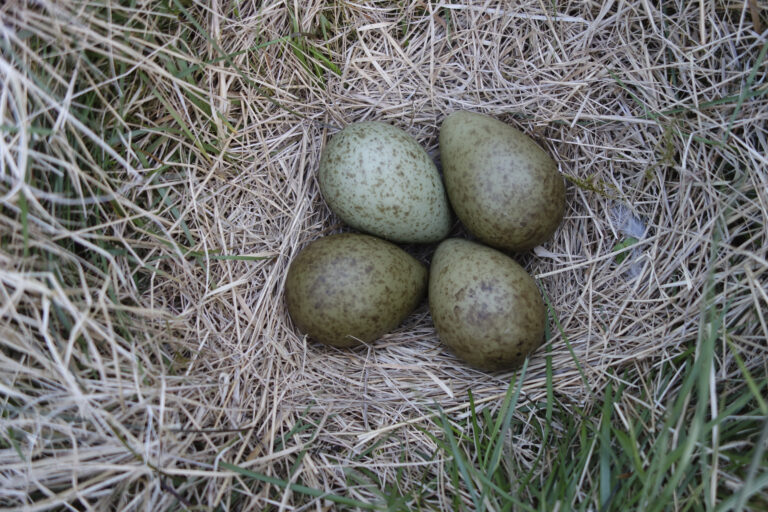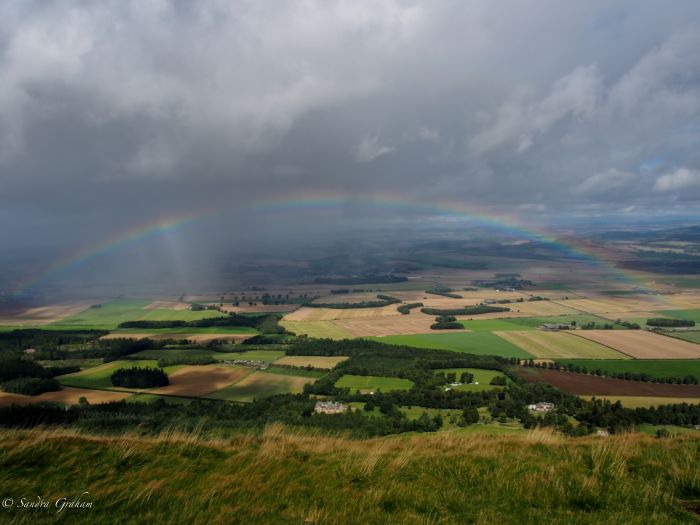Farming and crofting have a vital role to play in halting and reversing biodiversity loss in Scotland. In this blog Gabija Dragunaite, RSPB Scotland’s Policy Assistant, and Andrew Midgley, Senior Land Use Policy Officer, emphasise this point by outlining some of the RSPB’s own farming activity.
When people think about the RSPB, farming might not be the first thing that comes to mind – but we do farm, just like any other farmer.
Although public debates often frame environmental groups and farmers as opponents, that framing is too simplistic. Just as there are many farmers delivering positive conservation outcomes, we are a conservation organisation that is also farming.
We firmly believe that farming and crofting have a vital role to play in restoring Scotland’s biodiversity and when we acquired the farms referred to below, we did not stop the farming activity, we continued with it. We farm because the farming helps us help nature.
So, let’s look at our farming operations. We have four ‘in-hand’ farms (farms managed by us), where livestock and crop production support conservation efforts.

Chough by Jake Stephen
Oronsay
On the tidal island of Oronsay we farm under agreement with the owners, Oronsay Estate, for the benefit of Corncrake, Chough and other wildlife. Our flock of hill sheep and our herd of Luing Cattle effectively carry out the habitat management for us. The livestock grazing keeps the grass at an optimum height for birds like Chough to forage and the fields are managed in such a way that corncrake have enough time to breed. We can also try different approaches to see if they help, such as encouraging nettles in many areas to provide early cover for Corncrakes, which tend to arrive before the grass grows tall.
Having a healthy flock of sheep to graze the grass on Oronsay is vital for Chough to flourish, but recently, like many farmers, we have been trying to become much more precise in our livestock management. Since some veterinary medicines can reduce invertebrate populations associated with dung, we have been targeting the use of these medicines more effectively to try and ensure that species like the Chough have enough invertebrates on which to feed.

Barnacle Geese by Chris Gomersall
Loch Gruinart
Our Loch Gruinart nature reserve on Islay extends to 1700ha (including a large area of hill ground) and supports an array of priority species. Many of the species thrive on farmed habitats and so we run a traditional farming enterprise with 200 suckler cows and 200 breeding ewes.
The livestock are managed in such a way that they deliver a variety of grassland and arable habitats that benefit species like the Chough or the Barnacle and White-fronted geese which arrive each autumn or the large numbers of wading birds that breed on the wetter areas.
But our farming operation is not only about delivering conservation objectives; we strive to produce the best quality livestock we can and to be as profitable as possible. We are continually adapting and trying out new ideas to find the best balance between sustainable livestock farming and effective conservation land management. In recent years we have reduced the size of our cattle to make our operation more efficient and we have been reducing the amounts of expensive chemicals needed to treat our sheep, which also helps wildlife at the same time.

Highland Cattle by Andy Hay
The Oa
Our Oa nature reserve is also on Islay. We manage 2000ha of wild landscape that is important for Chough, Golden Eagle, Hen Harrier and Twite. We farm 350 sheep and 120 cows to improve the habitats for these species. Here we rear hardier breeds such as Highland Cattle and Scottish Blackface sheep, which thrive on the open hill, crossed with more commercial breeds such as Shorthorn and Cheviot to maximise profits. But we are trying to improve the grazing conditions for the animals as well as refining habitat for Chough, Hen Harriers and invertebrates. Our Highland Cattle are now the owners of ‘no fence collars’. This new method of virtual fencing (the GPS collars alert cows when they reach a boundary) allows us to target areas and is an easy way to monitor cattle movements. In a similar way to the work on our other reserves, we’ve also been working with partners to use technology to reduce our veterinary medicine inputs, which should help protect dung invertebrates.
Great Yellow Bumblebee by Patrick Cashman
Onziebust
On Onziebust, which is on the island of Egilsay in Orkney, we are very much at the beginning of our farming journey, having taken control of the farming operation in 2017. Starting with 22 cattle, numbers have grown to a herd of 40 breeding cows alongside a flock of 150 ewes. With complete control over our own grazing, we are able to deliver and adjust the habitat management work we want to see.
We have some stunning semi-natural wetland habitats, which we keep in good shape with the cattle and some rotational topping. In 2024, across the nature reserve, we recorded 250 pairs of breeding waders including 80 pairs of Lapwing, 49 pairs of Curlew and a single pair of Black-tailed Godwits. We also manage large areas of the farm for wildflowers and bumblebees including the very rare Great Yellow Bumblebee. After 8 years, we are pleased with the progress made so far.
Wider farming activity in Scotland
We also work with other farmers right across the country because our nature reserves span over 70,000 ha of land and some of this can be farmed where it fits with reserve management objectives. Each year we enter into agreements with other farmers to allow grazing on our nature reserves. We currently offer grazing lets to around 50 farmers and we are also involved in partnership arrangements, and we have farming tenants.
Hope Farm in England
Outside Scotland, we also manage Hope Farm in England. Established as a demonstration farm, Hope Farm demonstrates how nature-friendly farming can be profitable and has seen a steady rise in breeding arable birds since 2000. For more details, visit Hope Farm.
Our farming work doesn’t stop here…
We think that partnership is key. In our next farming blog we will dive deeper into the practical advice and support we provide to farmers and crofters around Scotland, helping them to adopt more nature-friendly practices that are both sustainable and profitable.




